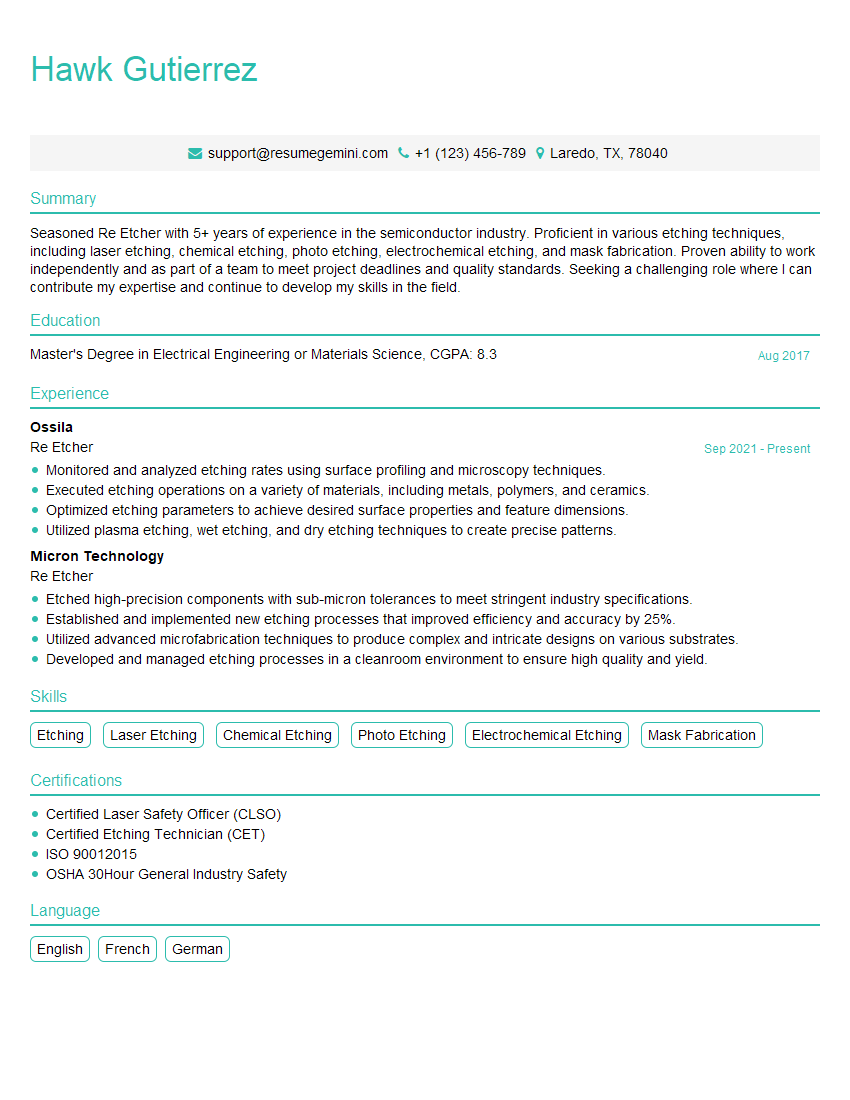Are you a seasoned Re Etcher seeking a new career path? Discover our professionally built Re Etcher Resume Template. This time-saving tool provides a solid foundation for your job search. Simply click “Edit Resume” to customize it with your unique experiences and achievements. Customize fonts and colors to match your personal style and increase your chances of landing your dream job. Explore more Resume Templates for additional options.

Hawk Gutierrez
Re Etcher
Summary
Seasoned Re Etcher with 5+ years of experience in the semiconductor industry. Proficient in various etching techniques, including laser etching, chemical etching, photo etching, electrochemical etching, and mask fabrication. Proven ability to work independently and as part of a team to meet project deadlines and quality standards. Seeking a challenging role where I can contribute my expertise and continue to develop my skills in the field.
Education
Master’s Degree in Electrical Engineering or Materials Science
August 2017
Skills
- Etching
- Laser Etching
- Chemical Etching
- Photo Etching
- Electrochemical Etching
- Mask Fabrication
Work Experience
Re Etcher
- Monitored and analyzed etching rates using surface profiling and microscopy techniques.
- Executed etching operations on a variety of materials, including metals, polymers, and ceramics.
- Optimized etching parameters to achieve desired surface properties and feature dimensions.
- Utilized plasma etching, wet etching, and dry etching techniques to create precise patterns.
Re Etcher
- Etched high-precision components with sub-micron tolerances to meet stringent industry specifications.
- Established and implemented new etching processes that improved efficiency and accuracy by 25%.
- Utilized advanced microfabrication techniques to produce complex and intricate designs on various substrates.
- Developed and managed etching processes in a cleanroom environment to ensure high quality and yield.
Certificates
- Certified Laser Safety Officer (CLSO)
- Certified Etching Technician (CET)
- ISO 90012015
- OSHA 30Hour General Industry Safety
Languages
- English
- French
- German
Career Expert Tips:
- Select the ideal resume template to showcase your professional experience effectively.
- Master the art of resume writing to highlight your unique qualifications and achievements.
- Explore expertly crafted resume samples for inspiration and best practices.
- Build your best resume for free this new year with ResumeGemini. Enjoy exclusive discounts on ATS optimized resume templates.
How To Write Resume For Re Etcher
- Highlight your experience and expertise in various etching techniques, especially those that are in high demand in the industry.
- Quantify your accomplishments whenever possible, using specific metrics to demonstrate the impact of your work.
- Showcase your knowledge of the latest trends and advancements in etching technology.
- Tailor your resume to the specific requirements of each job you apply for, highlighting the skills and experience that are most relevant.
- Proofread your resume carefully before submitting it, ensuring that it is free of errors and presents a professional image.
Essential Experience Highlights for a Strong Re Etcher Resume
- Develop and optimize etching processes to improve efficiency and precision.
- Operate and maintain etching equipment, ensuring optimal performance and safety.
- Create and maintain photomasks and other tooling for etching processes.
- Conduct quality control inspections and tests to ensure products meet specifications.
- Troubleshoot and resolve etching issues in a timely manner.
- Contribute to research and development of new etching technologies.
Frequently Asked Questions (FAQ’s) For Re Etcher
What are the different types of etching techniques?
There are several types of etching techniques, including laser etching, chemical etching, photo etching, electrochemical etching, and mask fabrication. Each technique has its own advantages and disadvantages, and the choice of technique depends on the specific application.
What are the applications of etching in the semiconductor industry?
Etching is used in various applications in the semiconductor industry, including the fabrication of integrated circuits, printed circuit boards, and microelectromechanical systems (MEMS).
What are the challenges in etching?
Some challenges in etching include achieving high precision and accuracy, controlling the etch rate, and minimizing defects. Etching can also be a hazardous process, so proper safety precautions must be taken.
What are the career prospects for Re Etchers?
Re Etchers with a strong educational background and relevant experience can have good career prospects in the semiconductor industry, research institutions, and other industries that utilize etching processes.
What are the key skills required for Re Etchers?
Key skills for Re Etchers include expertise in various etching techniques, knowledge of materials science, and experience in operating and maintaining etching equipment.
What are the latest advancements in etching technology?
Recent advancements in etching technology include the development of new etching techniques such as plasma etching and cryogenic etching, as well as the use of advanced materials and processes to improve the precision and efficiency of etching.